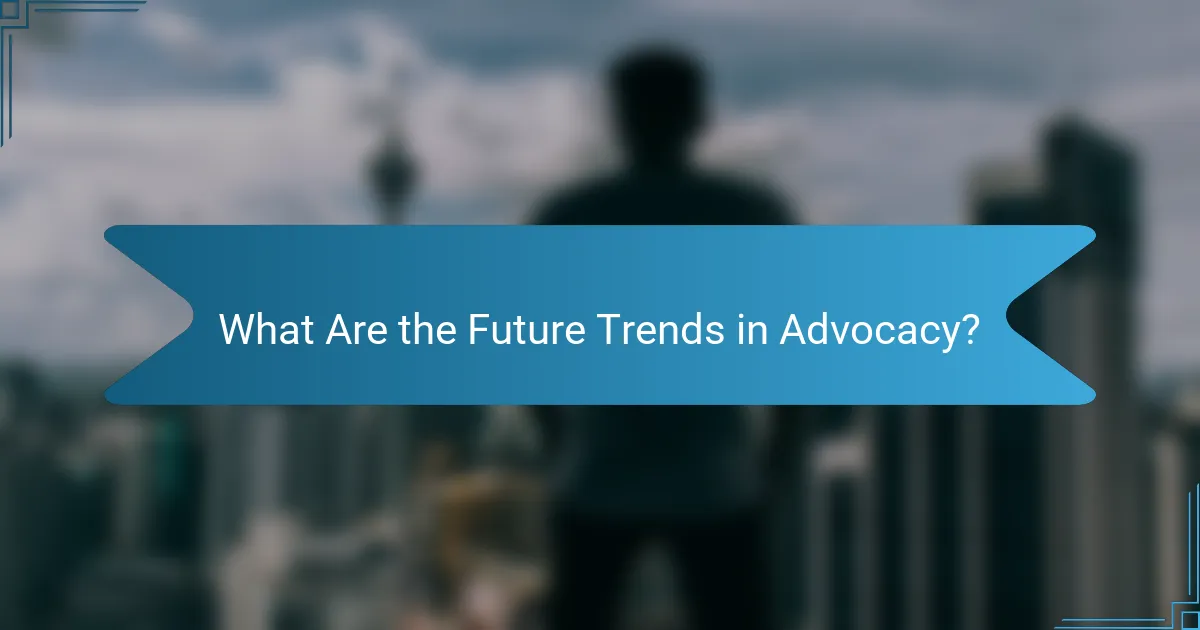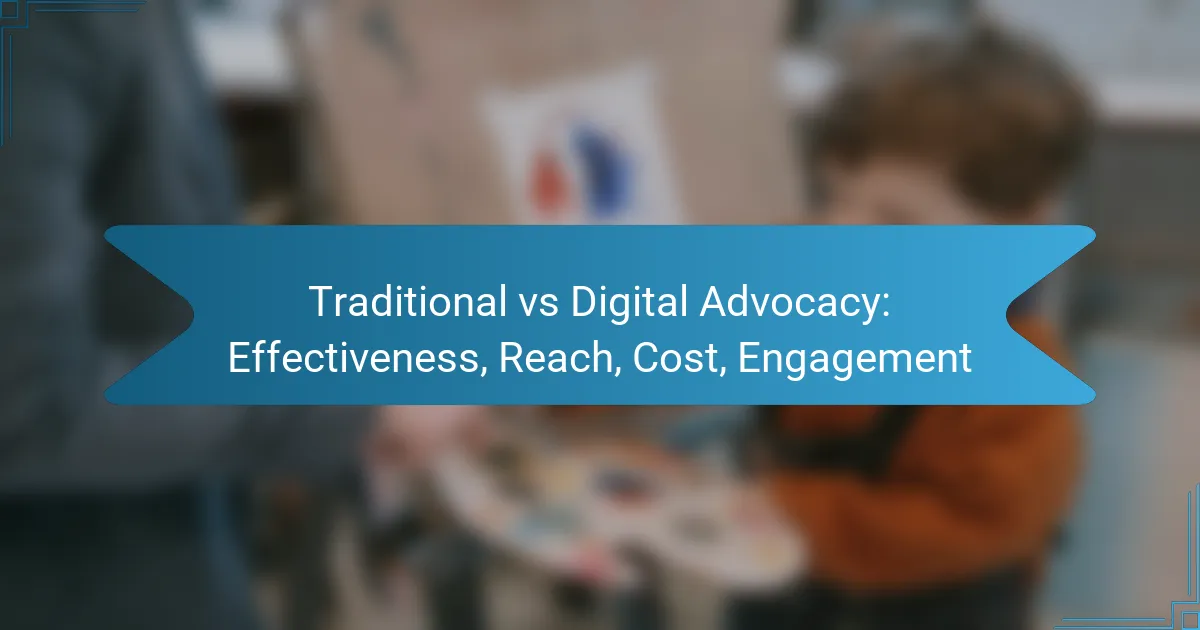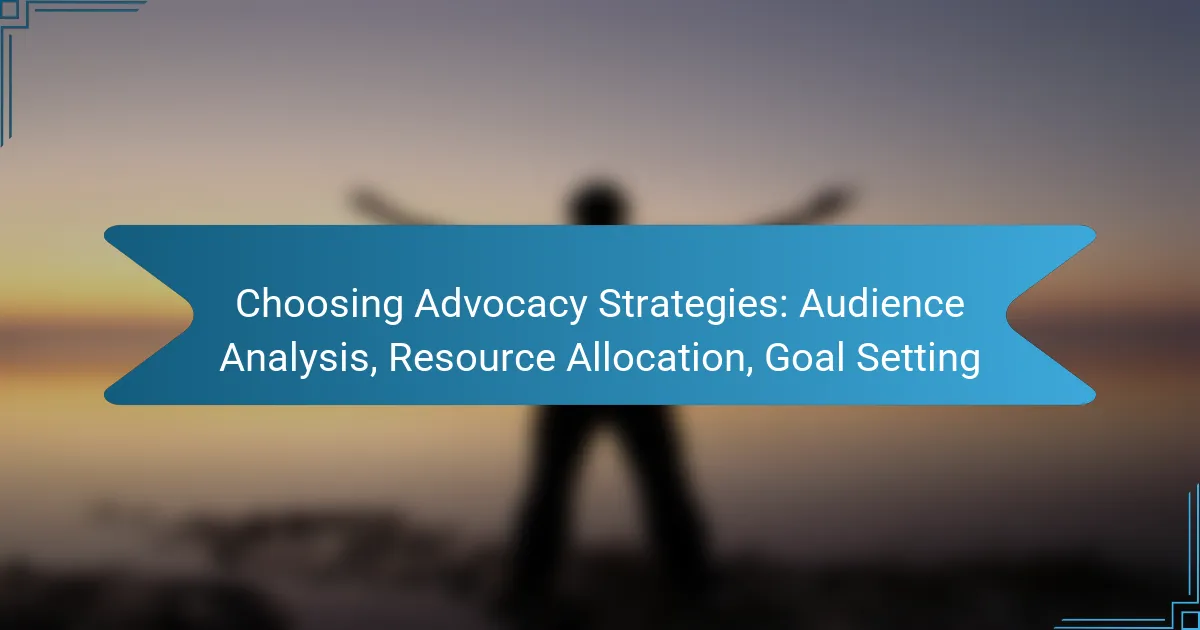In the evolving landscape of advocacy, traditional and digital methods each offer unique advantages in effectiveness, reach, cost, and engagement. Traditional advocacy thrives on building local support through personal interactions, fostering strong community ties. In contrast, digital advocacy harnesses technology to engage a broader, global audience rapidly, making it a powerful tool for influencing public opinion and decision-makers.

How Effective Are Traditional Advocacy Methods in the UK?
Traditional advocacy methods in the UK can be quite effective, particularly in building local support and fostering community involvement. These methods often rely on face-to-face interactions and established networks, which can lead to strong relationships and trust among stakeholders.
High community engagement
Traditional advocacy methods, such as town hall meetings, community events, and grassroots campaigns, tend to generate high levels of community engagement. These approaches allow advocates to connect directly with individuals, encouraging participation and fostering a sense of ownership over local issues.
For example, organizing a local rally or a petition drive can mobilize community members, creating a visible presence that attracts media attention and amplifies the message. Engaging with the community in person often leads to more meaningful conversations and stronger emotional connections to the cause.
Established trust and credibility
Traditional advocacy methods benefit from established trust and credibility, especially when advocates are recognized figures within the community. Personal relationships built over time can enhance the effectiveness of campaigns, as constituents are more likely to support initiatives proposed by familiar faces.
For instance, local leaders or respected organizations can lend their credibility to advocacy efforts, making it easier to persuade others. This trust can be crucial in sensitive issues where community members may be hesitant to engage with unfamiliar or digital-only campaigns.
Limited reach compared to digital
Despite their strengths, traditional advocacy methods often have a limited reach compared to digital platforms. While in-person events can engage local audiences effectively, they may not extend beyond geographic boundaries, restricting the potential audience size.
For example, a community meeting may attract dozens or hundreds of attendees, but a social media campaign can reach thousands or even millions with the right strategy. This limitation means that traditional methods may need to be complemented with digital strategies to maximize impact and reach a broader audience.

How Effective Are Digital Advocacy Methods in the UK?
Digital advocacy methods in the UK are highly effective due to their ability to reach diverse audiences quickly and engage them in real-time. These methods leverage technology to create impactful campaigns that resonate with the public and influence decision-makers.
Wider audience reach
Digital advocacy allows organizations to connect with a broader audience compared to traditional methods. Social media platforms, email campaigns, and online petitions can reach millions of users instantly, breaking geographical barriers.
For example, a well-targeted social media campaign can engage users across the UK, reaching urban and rural populations alike. This extensive reach is crucial for raising awareness and mobilizing support for various causes.
Real-time engagement metrics
One of the significant advantages of digital advocacy is the ability to track engagement metrics in real-time. Tools like Google Analytics and social media insights provide immediate feedback on how audiences interact with campaigns.
These metrics help organizations adjust their strategies quickly, optimizing content and outreach efforts based on what resonates most with their audience. For instance, if a particular post garners high engagement, similar content can be produced to maintain momentum.
Lower cost per engagement
Digital advocacy typically incurs lower costs per engagement compared to traditional methods such as print advertising or direct mail. Online campaigns can be executed with minimal budgets, especially when leveraging organic reach through social media.
Organizations can run effective campaigns with budgets ranging from a few hundred to several thousand pounds, depending on their goals. This cost-effectiveness allows for more frequent and diverse campaigns, maximizing outreach without straining resources.

What Are the Key Differences in Reach?
The primary difference in reach between traditional and digital advocacy lies in their geographic limitations and global capabilities. Traditional methods often confine outreach to local or regional audiences, while digital platforms can engage a worldwide audience almost instantaneously.
Geographic limitations of traditional methods
Traditional advocacy methods, such as print media, direct mail, and in-person events, typically focus on specific geographic areas. This can limit the audience to local communities or regions, making it challenging to engage with broader demographics. For example, a local newspaper may only reach readers within a certain city or county.
Additionally, the costs associated with traditional outreach can increase significantly when attempting to expand reach beyond local boundaries. Travel expenses for events or distribution costs for printed materials can quickly add up, making it less feasible for organizations with limited budgets.
Global outreach of digital platforms
Digital advocacy leverages online platforms, such as social media, email campaigns, and websites, to reach a global audience. This allows organizations to connect with supporters and stakeholders from various countries and cultures, often at a fraction of the cost of traditional methods. For instance, a single social media post can be shared across continents within minutes.
Moreover, digital tools enable targeted outreach based on interests and demographics, enhancing engagement with specific groups. Organizations can utilize analytics to refine their strategies and maximize their impact, ensuring that their messages resonate with diverse audiences around the world.

What Are the Cost Comparisons?
Cost comparisons between traditional and digital advocacy reveal significant differences in initial investments and ongoing expenses. Traditional advocacy often requires higher upfront costs, while digital campaigns tend to have lower ongoing costs, making them more accessible for many organizations.
Higher upfront costs for traditional advocacy
Traditional advocacy methods, such as print advertising, direct mail, and in-person events, typically require substantial initial investments. For instance, organizing a large rally or producing printed materials can run into thousands of dollars. These costs can include venue rentals, printing, staffing, and logistics.
Organizations should be prepared for these expenses and consider their budget carefully. While traditional methods can create a strong impact, the financial commitment can be a barrier for smaller groups or those with limited resources.
Lower ongoing costs for digital campaigns
Digital advocacy offers a more cost-effective approach with lower ongoing expenses. Platforms like social media, email marketing, and online petitions often have minimal costs associated with their use, especially when leveraging organic reach. Paid advertising on these platforms can also be tailored to fit various budgets, allowing for flexibility.
Moreover, digital campaigns can reach a wider audience without the recurring costs of traditional media. For example, a well-executed social media campaign can engage thousands for a fraction of the cost of a traditional campaign. Organizations should take advantage of these lower costs while ensuring they maintain quality and engagement in their messaging.

How Do Engagement Levels Compare?
Engagement levels in traditional and digital advocacy vary significantly, impacting how effectively messages are communicated. Traditional advocacy often relies on personal interactions, while digital advocacy utilizes technology to foster engagement through interactive features.
In-person interactions in traditional advocacy
In-person interactions are a hallmark of traditional advocacy, allowing for direct communication and relationship building. These face-to-face engagements can include town hall meetings, rallies, and one-on-one discussions, which often lead to deeper emotional connections and immediate feedback.
However, traditional methods can be limited by geography and time constraints, making it challenging to reach a broader audience. Organizers should consider the costs associated with venues and logistics, which can vary widely depending on location and scale.
Interactive features in digital advocacy
Digital advocacy leverages interactive features such as social media campaigns, online petitions, and webinars to engage a wider audience. These platforms allow for real-time interaction, enabling advocates to respond quickly to public sentiment and mobilize support efficiently.
While digital engagement can reach thousands or even millions at a lower cost compared to traditional methods, it may lack the personal touch that in-person interactions provide. Advocates should aim to create compelling content that encourages participation, such as polls or live Q&A sessions, to enhance engagement levels.

What Are the Best Practices for Combining Both Approaches?
Combining traditional and digital advocacy can enhance effectiveness, broaden reach, and improve engagement. Best practices include aligning messaging, leveraging data from both methods, and ensuring a seamless experience for supporters.
Integrating online and offline strategies
To effectively integrate online and offline strategies, start by ensuring consistent messaging across both platforms. For example, if a campaign promotes a community event, use social media to drive attendance while also distributing flyers in the area.
Consider using QR codes on printed materials that link to online resources or registration pages. This bridges the gap between physical and digital engagement, allowing supporters to interact with your campaign in multiple ways.
Utilizing data from both methods
Data collection from both traditional and digital advocacy methods is crucial for understanding audience behavior and preferences. Use surveys at events to gather feedback and combine this with analytics from online campaigns to create a comprehensive view of your supporters.
Regularly analyze engagement metrics, such as email open rates and social media interactions, alongside attendance figures from offline events. This will help you identify which strategies resonate most and allow for adjustments to improve future campaigns.

What Are the Future Trends in Advocacy?
Future trends in advocacy are increasingly shaped by technology, social media, and data analytics. These elements enhance the effectiveness, reach, and engagement of advocacy efforts, making them more dynamic and responsive to public sentiment.
Increased Use of Digital Platforms
The shift towards digital platforms is a defining trend in advocacy. Organizations are leveraging social media, websites, and email campaigns to reach broader audiences quickly and efficiently. This digital approach allows for real-time engagement and feedback, which traditional methods often lack.
For example, a campaign on platforms like Twitter or Instagram can mobilize thousands of supporters within hours, compared to weeks or months for traditional outreach methods. This immediacy can significantly amplify the impact of advocacy messages.
Data-Driven Decision Making
Data analytics is becoming essential in shaping advocacy strategies. By analyzing engagement metrics, organizations can tailor their messages and target specific demographics more effectively. This approach not only improves outreach but also enhances the overall effectiveness of campaigns.
For instance, using data to identify which issues resonate most with specific communities can lead to more focused and successful advocacy efforts. Organizations that harness data effectively can adapt their strategies in real-time, maximizing their impact.
Emphasis on Community Engagement
Future advocacy trends highlight the importance of community engagement. Building relationships with local communities fosters trust and encourages participation. Engaging community members in the advocacy process can lead to more authentic and powerful campaigns.
Strategies such as hosting community forums, workshops, or collaborative events can deepen connections and enhance support. This grassroots approach often results in more sustainable advocacy efforts, as community members feel a sense of ownership over the issues at hand.
Integration of Multimedia Content
The use of multimedia content is on the rise in advocacy campaigns. Videos, infographics, and interactive content can convey messages more compellingly than text alone. This trend caters to diverse audience preferences and increases the likelihood of message retention.
For example, a short video highlighting personal stories related to a cause can evoke emotional responses and drive action more effectively than a written article. Organizations should consider incorporating various media formats to enhance their advocacy efforts.
Focus on Sustainability and Long-Term Impact
Advocacy is increasingly focusing on sustainability and long-term impact rather than short-term wins. This shift encourages organizations to develop strategies that consider the broader implications of their work on communities and the environment.
For instance, campaigns that promote renewable energy not only address immediate concerns but also contribute to long-term environmental goals. Advocacy efforts that align with sustainable practices can attract support from a growing number of environmentally conscious individuals and organizations.



